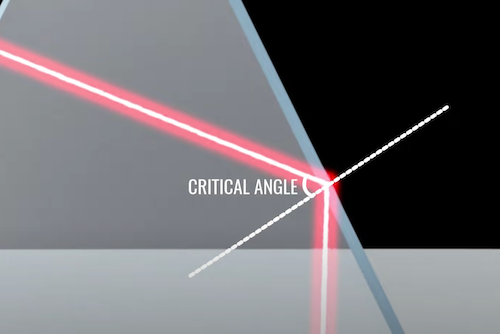Optical fiber is a very thin strand of glass, almost thin like human hair, and it serves as a waveguide for light to transmit over a long distance.
This strand of glass is known as the “core” and is always wrapped in another layer of glass named “cladding” to enable Total Internal Reflection and have the light signal transmitted along to the destination.
The core and the cladding form a unit and a fiber optic cable could consist of hundreds of, sometimes thousands of these units.

Video: Total Internal Reflection explained by Lesics
There are two types of fiber optic cables, single-mode, and multi-mode. A fiber optic cable has its advantages (often compared to a copper cable) and they are listed below.
Compared to a coaxial cable, fiber has far less signal loss, enabling signal transmission over a greater distance. A coaxial cable suffers significant signal loss as the distance goes up. A copper HDMI cable is mostly planned to be less than 50 ft, while you could easily find a fiber optic HDMI cable that stretches up to 500ft.
You may be interested: 4K HDMI 2.0 extender via fiber up to 1000ft
A fiber optic cable transmits data via the medium of light. The fiber core and the cladding have different reflex indicators and they deflect incoming light from a particular angle. The angle is well calculated and when the light signal transmits in a fiber optic cable, it bounces in a zig-zag route to the other end. Though it’s slower than light, it’s still faster than a metal wire.
Fiber optic cable transmits data via the medium of light going through a tiny strand of glass. The current maximum bandwidth for fiber-optic cabling is 100Gbps. Its transmission capacity is much more higher than that of a twisted pair cable.
You may be interested: 8K HDMI 2.1 fiber optic cable perfect for game and your home theater
Fiber is protected from temperature changes, extreme weather, and humidity, all of which can interfere with copper cable communication. Also, the fiber does not carry an electric current, so it is not bothered by electromagnetic interference (EMI) which can hinder data transmission. In fact, fiber optic cables across the oceans are playing an indispensable role in the Internet worldwide web.
Fiber optic cables are thinner and lighter than metal wires. Compared to a copper wire with the same capacity, a fiber optic cable takes up less space and could be a better fit when space is a concern.
Copper is one of the most conductive materials of electricity and a copper cable can better sustain the electricity power along the transmission. This feature guarantees that the electrical power is well transferred and gets fed to the needed end of the device for stable performance.
Copper cable connectors are widely built into all kinds of electronics and consumer devices. It could be a time-saving decision to fetch you a copper cable and complete the setup in a short period of time.
Unlike a fiber optic cable, a copper cable is more malleable to bend and twist to any shape or direction. If you are preparing an audio/visual system for a road show, a copper cable could stand harsh treatment in the public and still work and perform as it shall.
People choose fiber optic cables over copper cables for some reasons and some of them can be explained by the advantages above — for a longer transmission distance, faster speed, better quality (thanks to the bandwidth), etc; for most cases, copper cable connection is built in the AV system as a default cabling option and it is necessary for most scenarios due to its strength of conduction and malleability.
AV Access offers different types of products that enhance your AV experience — KVM extenders, HDMI extenders, AV over IP solutions, and meeting room solutions. Developing along with the ProAV technology, we aim to provide products that make AV installation convenient and management easier for everyone. No matter what AV solutions you are looking for, we make it easy-to-use, and friendly to non-professionals.
Contact us
Source: https://www.avaccess.com/blogs/guides/fiber-optic-vs-copper-cable/
In case you have found a mistake in the text, please send a message to the author by selecting the mistake and pressing Ctrl-Enter.
#Fiber #Optic #Copper #Cable #Choose


